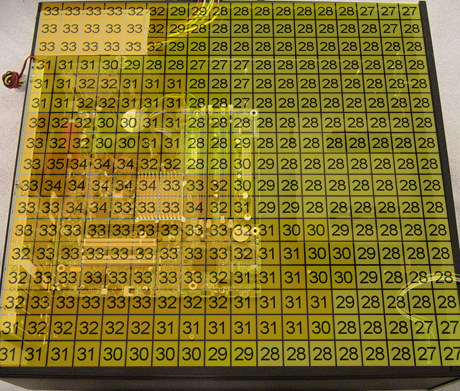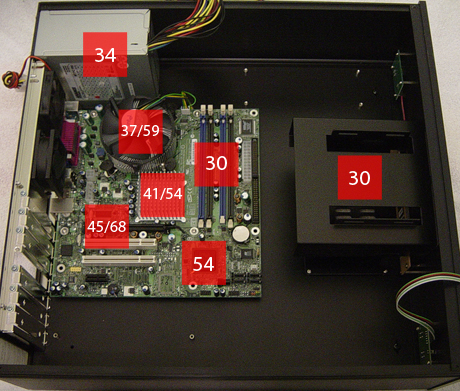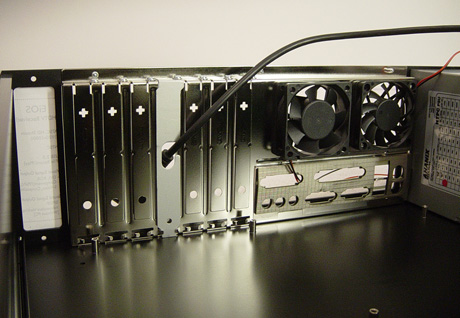Intel's Long Awaited BTX Form Factor
by Purav Sanghani on November 15, 2004 5:31 AM EST- Posted in
- Cases/Cooling/PSUs
Thermals Desktop ATX
We tested our D915GUX board and Pentium 550 CPU in Ahanix's D.Vine 5 HTPC chassis, the successor to the D.Vine 4 we reviewed last month, since it had the size of a typical mid tower case yet took on the form of a flat lying desktop case like the B300 to give a better idea of how this hardware performed in a case with sizes we are used to. Unlike Opus Technologies, Ahanix has a great deal of products, many of them cases which is their main focus. The first case we reviewed from Ahanix was their Black Knight. The Black Knight performed well in our thermal benchmarks while averaging at 50dBA in sound We again measure temperatures of the ambient air inch by inch to show how each component affects various areas of the case.
Click to Enlarge
It is evident that the warmest region in our desktop ATX system is between the CPU, Northbridge, and PCIe VGA card followed by the power supply. We also notice how the rear exhaust fans are pulling the warm air towards them to the outside. The D.Vine 5 has an extremely large footprint, 17" in width by 18" in depth, so there are many areas which are not being exposed to warm air such as the front corners as well as the left side of the case.

Click to Enlarge
We see here that the CPU, Northbridge heatsink and the PCIe VGA card are the hottest components in the system. The Southbridge also ran extremely hot at 54 degrees, but it is too small to have as great of an effect on the ambient air around it as did the other three. The power supply, on the other hand, measured to be 34 degrees which had a great affect on its surrounding air.

Click to Enlarge
Again, since the D.Vine 5 lies flat instead of upright like the TT-501 does, heat pockets mainly occur over the equipment giving off the heat instead of at the top of the case (the right side in this case) near the power supply.










77 Comments
View All Comments
ZobarStyl - Monday, November 15, 2004 - link
God looking at those small cases makes me tremble and remember my parent's old IBM Pentium I system where you had to remove the PSU and the CD drive to install the RAM. I was so glad when I saw computers moving AWAY from this type of design...forget footprint, I want a case I can actually work in.Either way, congrats to Intel on making a new Delleron case, but I'm simply not interested. Great for OEM's but useless for me, just like most of Intel's products...
As for #3's question, why does Intel need it outside of helping their OEM buddies? Dual core is only going to make Prescott's heat issues stand out further and their x20/30/40's on the roadmap still are clocked in the range where they are going to be high heat output. All that heat has to go somewhere...
shabby - Monday, November 15, 2004 - link
#5 that must be the canadian version, it'll keep us warm during winter by exhausting warm air into our faces.Jeff7181 - Monday, November 15, 2004 - link
Am I reading this right... warm air from the CPU is exhausted out the FRONT of the case????mcveigh - Monday, November 15, 2004 - link
I can't get past page 1??????skunkbuster - Monday, November 15, 2004 - link
will intel even need btx anymore? since they are probably going to be dumping the p4 in favor of the pM(eventually)?i thought one of the main reasons why btx was designed was to better handle the hotter p4 processors and to cool them more efficiently?
PuravSanghani - Monday, November 15, 2004 - link
Thanks MAME, problem fixed :)MAME - Monday, November 15, 2004 - link
thumbnail of this article doesn't load on front page